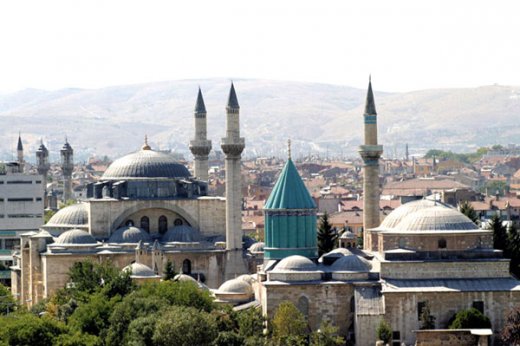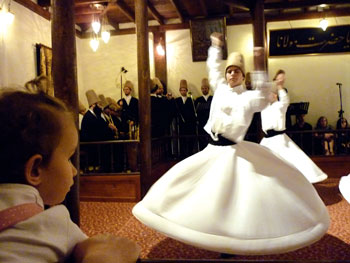SUFISM – Mowlânâ Jalâl-od-Dîn Rûmî UNESCO World Heritage Shams-i Tabrizi & the freedom of religion or belief.
Mowlânâ Jalâl-od-Dîn Rûmî et l’ordre mevlevi des derviches tourneurs

- Mausolée de Rûmî à Konya, vue d’ensemble
His epitaph reads: "Do not seek our tombs on this earth - our tombs are in the hearts of the enlightened."
http://mevlana.net/unesco_address.html
http://www.sacred-destinations.com/turkey/konya-mevlana-museum.htm
Rûmî est né à Balkh dans le grand Khorâssân iranien (l’antique Bactres de l’Empire achéménide, aujourd’hui en Afghanistan) en 1207 (604 de l’Hégire), mais il dut quitter sa ville natale avec sa famille à l’âge de 14 ans. Les raisons de ce départ, variant d’un hagiographe à l’autre, sont attribuées soit à la contestation des habitants de la ville à propos du titre de Sultan des savants donné à son père, le grand érudit Bahâ-ud-Dîn-Walad, théologien et prédicateur éminent, soit à un différend entre celui-ci et le philosophe attitré du roi, ou encore à la fuite devant le danger que représentait alors l’avancée des hordes mongoles parcourant la steppe, ou peut-être une accumulation de tous ces événements. De fait, la ville de Balkh fut détruite par Gengis Khan peu après que Rûmî l’eût quittée.
Après être passés par Neyshâbour (où Rûmî rencontre le grand poète mystique Attâr), La Mecque, Bagdad, ils s’installèrent à Konya, dans l’Empire ottoman, à l’invitation du sultan Key Ghobâd, comme de nombreux Persans fuyant les hordes mongoles. Son père meurt dans cette ville, alors que Rûmî n’a que 24 ans. Un an plus tard, il suit l’enseignement de Termazi, grand théoricien de Konya qui l’envoie étudier à Alep et à Damas afin d’y parfaire ses connaissances philosophiques et théologiques. C’est à Damas qu’il rencontrera pour la première fois le derviche Shams Tabrizi, qui transformera sa vie en faisant de lui un mystique extatique.
Le collège où Rûmî, docteur en théologie, enseigne jurisprudence et loi islamiques, est fréquenté par de nombreux disciples. A 36 ans, on commence à l’appeler Mowlânâ, notre maître. Son érudition attire à Konya les plus illustres savants du monde dit civilisé.
On rapporte que c’est au cours de sa retraite de quarante jours en compagnie de Shams Tabrizi à Konya qu’il se met à tournoyer à la manière des derviches tourneurs et apprend à jouer du luth. « Plusieurs voies mènent à Dieu, j’ai choisi celle de la musique et de la danse », écrira-t-il. C’est en tout cas après cet épisode décisif de sa vie qu’il fonda la tarîqa mawlawiya ou confrérie mevlevi.

- Cérémonie à la loge mevlevi de Bursa http://www.allaboutturkey.com/konya.htm
Photo : Eric Nosjean
L’ordre mevlevi des derviches tourneurs de Turquie
Comme Rûmî l’avait souhaité, Hessâmeddin Tchalabi, son disciple dès l’adolescence, devient son successeur spirituel lorsqu’il décède en 1273. C’est Hessâmeddin qui écrira et mettra en forme le Masnavi, la grande œuvre de Rûmî, tandis que celui-ci lui en récitait les poèmes. Guidant la communauté fondée par son maître, Hessâmeddin fit en sorte qu’elle continue à respecter les idées et les principes du défunt. Quand Hessâmeddin meurt à son tour en 1284, Soltân Walad, fils aîné de Rûmî, devient le sheykh des Mevlevi : il organise ses disciples en un ordre soufi véritable avant que son propre fils, Aref Tchalabi, ne lui succède en 1312. Une chaîne de successions directes rattache le maître actuel de la Mawlawîya à ses prédécesseurs.
Après la mort de Rûmî, l’ordre des mevlevis connaît une ascension notable sous la protection des sultans seldjoukides et ottomans, se déployant jusque dans le monde arabe et les Balkans. Il cultive la poésie persane (Rûmî s’exprimait et écrivait en persan), la musique, la calligraphie, et codifie ses cérémonies, dont la danse, dans ses tekke – ou monastères derviches – des principales villes de l’empire.
La progression spirituelle du soufi mevlevi s’inscrit dans le cadre d’une retraite de mille et un jours consistant en périodes de silence, d’isolement en cellule, d’étude et de corvées domestiques. Ce temps de formation s’accomplit en grande partie dans la cuisine du monastère, lieu hautement initiatique, où le novice est lentement mené à maturité spirituelle. Il s’initie à la musique et à la danse, à la lecture du Masnavi, au zikhr (invocation répétitive des noms divins) et à la méditation. Cette initiation est clôturée par une cérémonie d’investiture qui fait du novice un sheikh. On lui remet alors deux attributs symboliques, le manteau (le souf) et la coiffe rituels. Il peut ensuite choisir entre une vie de célibataire au monastère ou une vie de famille à l’extérieur, tout en restant lié à sa communauté, cas d’exception dans l’histoire du soufisme. … Read More http://www.teheran.ir/Mowlânâ Jalâl-od-Dîn Rûmî
Shams-i-TabrÄ�zÄ� or Shams al-Din Mohammad (born 1185, died ca.1248) was a Persian Muslim, who is credited as the spiritual instructor of Mewlana Jalal ad-Din Muhammad Balkhi, also known as Rumi and is referenced with great reverence in Rumi’s poetic collection, in particular Diwan-i Shams-i Tabrizi (The Works of Shams of Tabriz).
Tradition holds that Shams taught Rumi in seclusion in Konya for a period of forty days, before fleeing for Damascus. The tomb of Shams-i Tabrizi was recently nominated to be a UNESCO World Heritage Site.
Sufism or taṣawwuf (Arabic: تصوّف) is defined by its adherents as the inner, mystical dimension of Islam. A practitioner of this tradition is generally known as a ṣūfÄ� (صُوفِيّ). Another name for a Sufi is Dervish.
Classical Sufi scholars have defined Sufism as „a science whose objective is the reparation of the heart and turning it away from all else but God“. Alternatively, in the words of the Darqawi Sufi teacher Ahmad ibn Ajiba, „a science through which one can know how to travel into the presence of the Divine, purify one’s inner self from filth, and beautify it with a variety of praiseworthy traits“. http://en.wikipedia.org/wiki/Sufism
About http://iranculture.ca/dev/
The development of the role of cultural relations and the growth of attention devoted to its aspects is closely connected with modern development of civilization and with the development of international relations along with the continuous increase in their intensity.
Culture is inseparably connected with not only international cultural relations, but also to create the necessary conditions for the harmonic development of human society. In other word Culture is reflected in all human activities and in their results.
Cultural relations have great significance for international relations from the viewpoint of how well cross-cultural communication functions. According to expert analyses inefficacy of international negotiations is from up to 70% caused by mutual misunderstanding of members of different cultural systems. In the first place the recognition of one’s own culture and at the same time also obtaining knowledge about different cultures and their environment belong to the main pillars of proper communication.
Regarding to the above mentioned points, Iran Embassies in abroad try for expansion of cultural ties with the countries in all around the world and believe that based on key role of culture in International Relations, cooperation in this field could help promote bilateral and multilateral economic, political and social activities as well.
The Cultural Centre of Iran in Canada also believes that there is need for promoting Tehran-Ottawa cultural exchanges and do its best for achieving cultural goals of the two countries in different fields including cinema, arts, language teaching ,exchange of views and etc .
Iran’s great potential in the field of tourism is also essential in this regard. Iran is open to tourists from all over the world and over 1,500,000 tourists visit various cultural and historical sites in this country each year. Diverse climatic conditions as well as deep-rooted civilization have transformed Iran into a tourist hub. So it has the potential to create suitable grounds to further expansion of the tourism industry cooperation with Denmark. Activating such fields also could be the best opportunity for the exchange of views among intellectuals and scholars of the two countries.
The cultural Centre of Iran in Canada has the responsibility of coordinating Cultural activities in Canada; expansion of the cultural, scientific, educational religious, and artistic relations between two countries; introducing the Islamic and Iranian culture and civilization to the Canadian people; promoting and consolidating relations among Universities scientific and cultural institutions of the two countries.
Last but not least, as we constantly strive to improve out cultural operations, we would like to ask you to contact us and provide us with your questions or concerns on all aspects of our work.
http://www.iranhumanrights.org/
http://en.wikipedia.org/wiki/Shams_Tabrizi
http://en.wikipedia.org/wiki/Rumi
http://en.wikipedia.org/wiki/Diwan-e_Shams-e_Tabrizi
http://en.wikipedia.org/wiki/Dhikr
http://en.wikipedia.org/wiki/Qadiriyya
http://www.amnesty.org/en/economic-social-and-cultural-rights
UNPO Co-Hosts „Minority Rights In Iran“ Event At United Nations
http://www.ohchr.org/EN/Issues/FreedomReligion/Pages/FreedomReligionIndex.aspx
http://portal.unesco.org/800th Anniversary of the Birth of Mawlana Jalal-ud-Din Balkhi-Rumi
http://www.facebook.com/Hz. Mevlâna
http://www.facebook.com/MevlanaveSemsHz
http://www.facebook.com/LeCentreCulturelDIranAOttawa
http://www.facebook.com/Cultural-Centre-of-the-Islamic-Republic-of-Iran-Ottawa
#sufism Persecution
http://www.transparency-for-iran.org
http://www.hrw.org/middle-eastn-africa/iran
Iran: UN human rights body concerned over executions and minority rights
http://www.hrw.org/europecentral-asia/turkey
http://www.hrw.org/europecentral-asia/azerbaijan
Inspirations for Rio +20 Summit on #sustainable #development in #brazil: #private set of pictures #anatolia #turkey #tourism #***** hotel #spa tour autumn 2011:
http://www.flickr.com/photos/rumisuficelaleddinimevlana/
Comments are closed.